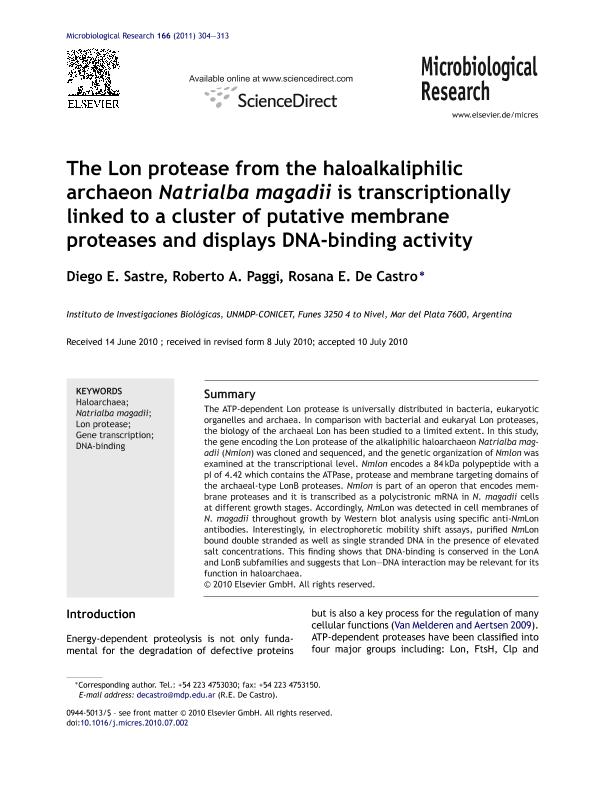Artículo
The Lon protease from the haloalkaliphilic archaeon Natrialba magadii is transcriptionally linked to a cluster of putative membrane proteases and displays DNA-binding activity
Fecha de publicación:
05/2011
Editorial:
Elsevier Gmbh
Revista:
Microbiological Research
ISSN:
0944-5013
Idioma:
Inglés
Tipo de recurso:
Artículo publicado
Clasificación temática:
Resumen
The ATP-dependent Lon protease is universally distributed in bacteria, eukaryotic organelles and archaea. In comparison with bacterial and eukaryal Lon proteases, the biology of the archaeal Lon has been studied to a limited extent. In this study, the gene encoding the Lon protease of the alkaliphilic haloarchaeon Natrialba magadii (Nmlon) was cloned and sequenced, and the genetic organization of Nmlon was examined at the transcriptional level. Nmlon encodes a 84 kDa polypeptide with a pI of 4.42 which contains the ATPase, protease and membrane targeting domains of the archaeal-type LonB proteases. Nmlon is part of an operon that encodes membrane proteases and it is transcribed as a polycistronic mRNA in N. magadii cells at different growth stages. Accordingly, NmLon was detected in cell membranes of N. magadii throughout growth by Western blot analysis using specific anti-NmLon antibodies. Interestingly, in electrophoretic mobility shift assays, purified NmLon bound double stranded as well as single stranded DNA in the presence of elevated salt concentrations. This finding shows that DNA-binding is conserved in the LonA and LonB subfamilies and suggests that Lon–DNA interaction may be relevant for its function in haloarchaea.
Palabras clave:
Haloarchaea
,
Natrialba Magadii
,
Lon Protease
,
Gene Transcription
,
Dna-Binding
Archivos asociados
Licencia
Identificadores
Colecciones
Articulos(IIB)
Articulos de INSTITUTO DE INVESTIGACIONES BIOLOGICAS
Articulos de INSTITUTO DE INVESTIGACIONES BIOLOGICAS
Citación
Sastre, Diego Emiliano; Paggi, Roberto Alejandro; de Castro, Rosana Esther; The Lon protease from the haloalkaliphilic archaeon Natrialba magadii is transcriptionally linked to a cluster of putative membrane proteases and displays DNA-binding activity; Elsevier Gmbh; Microbiological Research; 166; 4; 5-2011; 304-313
Compartir
Altmétricas




